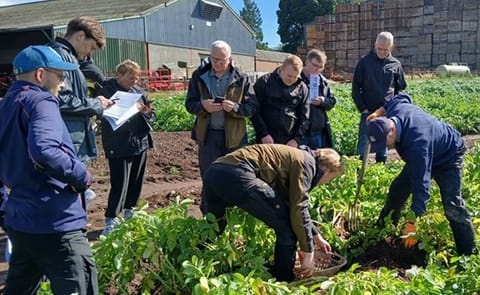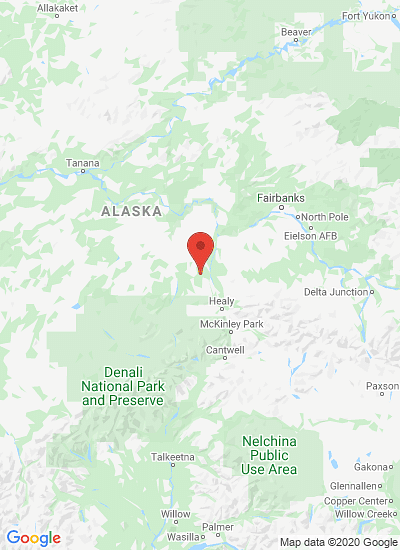University of Alaska Fairbanks
Scientists look for source of Alaska potato blight

Potato late blight, that same disease that caused the Irish Potato Famine, resurfaced in Alaska this fall.
This wasn’t the first time the disease, widespread in the Lower 48 and worldwide, came to Alaska. Plant pathologist Jenifer McBeath suspects it won’t be the last – and outbreaks are now becoming more commonplace, she said.
When McBeath visited Taiwan in 1999, she encountered the effects of late blight for the first time.
Where farmers once harvested tons of potatoes a year, in 1999 they took little baskets to collect their meager yield. The wind-borne fungus-like disease leapfrogged field-to-field, destroying potato plants in its wake.
“It was just devastating. … The whole field just died, like being burned,” McBeath said.
In 1996, Alaska began exporting seed potatoes – that is, potatoes grown to plant, not eat – to Taiwan under McBeath’s guidance. When late blight spread through the back-to-back Taiwanese fields in 1999, the government there suspected Alaska potatoes as the source of the disease. McBeath, head of the plant pathology laboratory at the University of Alaska Fairbanks (UAF), traced the source back to California.
Tablestock potatoes aren’t as strictly checked for diseases because they aren’t expected to be be planted, but the farmers in Taiwan used these potatoes to stock their farms. McBeath’s sleuthing ultimately rebuilt her relationship with the government in Taiwan. Each year, late blight could potentially impact the farms that grow her potatoes. The ever-increasing outbreaks of potato late blight in Alaska endanger the reputation of her disease-free seed potato program and Alaska’s $3-million-per-year potato export economy.
Stephen Brown returned from the field in early September to find a note stuck to his computer at the Cooperative Extension Service (CES) office in Palmer. Late blight struck two farms back-to-back during this wet autumn – one in Palmer and one in the Interior. Palmer has seen late blight in the past, but the Interior outbreak was new. CES flooded the media with prevention information the next day.

Late blight affected potato plants
Potato late blight thrives in cool and wet conditions. The disease infects the plant above ground, occasionally underground, and chews through tissue. The disease spreads by climbing out of the leaf and being carried away by the wind, so there is often white fluff under the leaf around the borders of rotting brown spots. Farmers can prevent introducing late blight not only by buying disease-free potatoes (that is, not potatoes from the supermarket), but also by asking for test results to accompany the potatoes.
At first, the farmers involved had second thoughts about CES going to the media to provide information about the outbreak – this is, after all, a potentially life-threatening problem for a farm. In the end, the public was more informed, and this benefit quelled farmers’ fears, Brown said. Because CES provides solutions to common agriculture problems, farmers feel comfortable approaching the service about outbreaks on their farms, he said.
Within two days all farms in the Alaska sprayed fungicide to keep any new infections at bay, Brown said. The spray buggies held up traffic around farming communities, he said. A potato disease outbreak like this initially brought McBeath to the forefront of seed potato export more than 20 years ago. A potato ring rot outbreak crippled the Lower 48?s trust in Alaska seed potatoes. Alaska already lagged behind the competition because of shipping costs. McBeath suggested they level the playing field – both Alaska and the Lower 48 need to pay when shipping to China. Now, they produce more than a hundred thousand plantlets – baby, lab-grown potatoes – each year to plant at local farms that will eventually export seed potatoes to China.
McBeath’s potatoes are shielded from the diseases in Alaska when in the lab, where they are grown free of a number of common diseases. If they can be planted, grown for a few generations and exported without succumbing to disease, they receive the certified moniker “disease-free,” she said. If late blight comes to any of her farms, Alaska’s global reputation as a seed potato exporter falls apart.
“It’s a time bomb that’s waiting to be exploded… the way the state has been handling this disease just cannot continue,” McBeath said. Since the disease arrived in Alaska in the 90s, the response has been to observe, educate and prevent. “It’s not helping anything. What we should do is take a proactive attitude,” McBeath said. No more speculation, she said. Her lab is identifying the strain of this latest outbreak of late blight, the first step toward pinpointing how the disease arrived here.
Alaska’s geographic isolation makes it difficult to fit with the nationwide disease response infrastructure – meaning, by the time Alaska gets test results from centers in the Lower 48, late blight could irreparably spread, she said.
Too many regulations may turn off farmers from coming to CES for advice, Brown said. The farmers came forward without prompting in September as a result of a partnership formed over the course of 100 years, he said. Peer pressure between farmers works well enough for communicating the gravity of the situation, he said. “Sometimes when you over-regulate, you actually discourage people from exhibiting good behavior,” Brown said.








